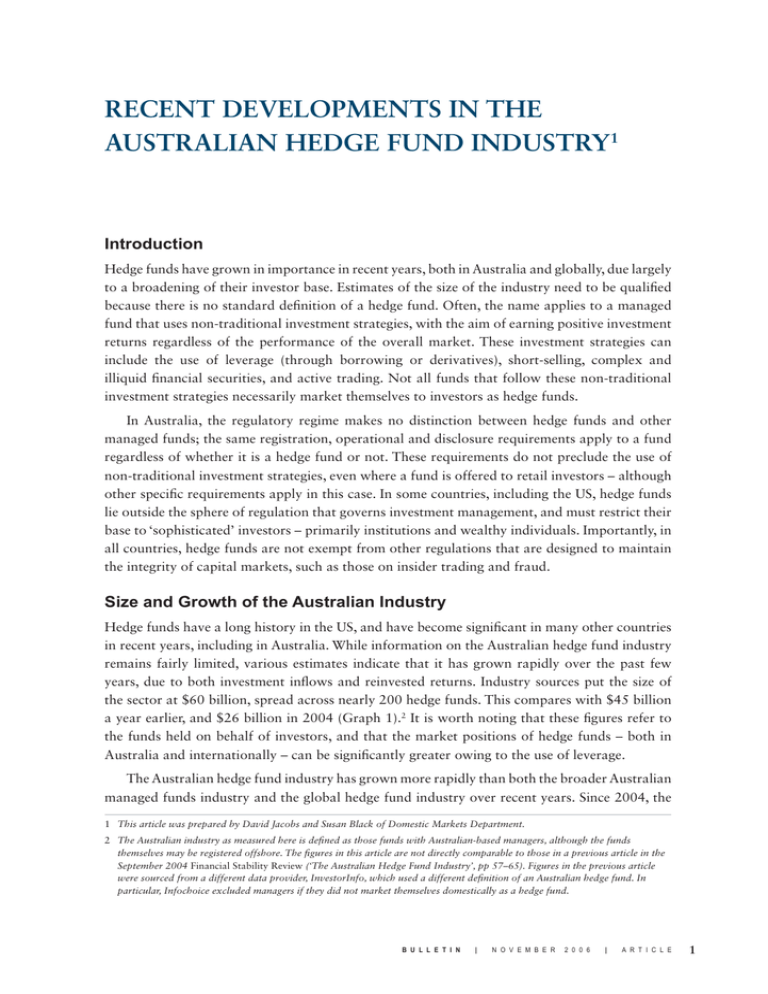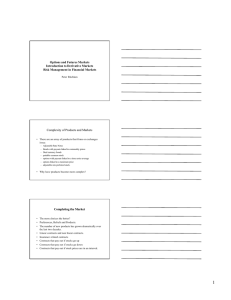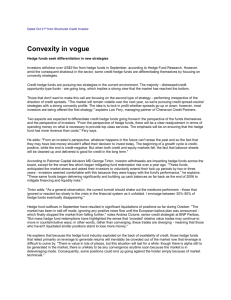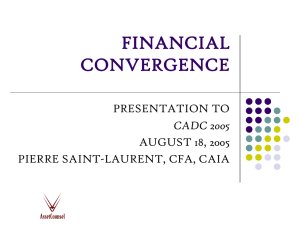RECENT DEVELOPMENTS IN THE AUSTRALIAN HEDGE FUND INDUSTRY Introduction 1
advertisement

RECENT DEVELOPMENTS IN THE AUSTRALIAN HEDGE FUND INDUSTRY1 Introduction Hedge funds have grown in importance in recent years, both in Australia and globally, due largely to a broadening of their investor base. Estimates of the size of the industry need to be qualified because there is no standard definition of a hedge fund. Often, the name applies to a managed fund that uses non-traditional investment strategies, with the aim of earning positive investment returns regardless of the performance of the overall market. These investment strategies can include the use of leverage (through borrowing or derivatives), short-selling, complex and illiquid financial securities, and active trading. Not all funds that follow these non-traditional investment strategies necessarily market themselves to investors as hedge funds. In Australia, the regulatory regime makes no distinction between hedge funds and other managed funds; the same registration, operational and disclosure requirements apply to a fund regardless of whether it is a hedge fund or not. These requirements do not preclude the use of non-traditional investment strategies, even where a fund is offered to retail investors – although other specific requirements apply in this case. In some countries, including the US, hedge funds lie outside the sphere of regulation that governs investment management, and must restrict their base to ‘sophisticated’ investors – primarily institutions and wealthy individuals. Importantly, in all countries, hedge funds are not exempt from other regulations that are designed to maintain the integrity of capital markets, such as those on insider trading and fraud. Size and Growth of the Australian Industry Hedge funds have a long history in the US, and have become significant in many other countries in recent years, including in Australia. While information on the Australian hedge fund industry remains fairly limited, various estimates indicate that it has grown rapidly over the past few years, due to both investment inflows and reinvested returns. Industry sources put the size of the sector at $60 billion, spread across nearly 200 hedge funds. This compares with $45 billion a year earlier, and $26 billion in 2004 (Graph 1).2 It is worth noting that these figures refer to the funds held on behalf of investors, and that the market positions of hedge funds – both in Australia and internationally – can be significantly greater owing to the use of leverage. The Australian hedge fund industry has grown more rapidly than both the broader Australian managed funds industry and the global hedge fund industry over recent years. Since 2004, the 1 This article was prepared by David Jacobs and Susan Black of Domestic Markets Department. 2 The Australian industry as measured here is defined as those funds with Australian-based managers, although the funds themselves may be registered offshore. The figures in this article are not directly comparable to those in a previous article in the September 2004 Financial Stability Review (‘The Australian Hedge Fund Industry’, pp 57–65). Figures in the previous article were sourced from a different data provider, InvestorInfo, which used a different definition of an Australian hedge fund. In particular, Infochoice excluded managers if they did not market themselves domestically as a hedge fund. B U L L E T I N | N O V E M B E R 2 0 0 6 | A R T I C L E 1 Graph 1 Australian Hedge Fund Industry As at June $b 60 ■ Funds under management (LHS) ■ Per cent of global industry (RHS) % 3.0 50 2.5 40 2.0 30 1.5 20 1.0 Australian hedge fund industry has grown from 3 per cent to 5 per cent of the Australian managed funds industry, and from just over 1 per cent to almost 3 per cent of the global hedge fund industry. Institutional Investors Both globally and in Australia, a major driver of the growth of the hedge fund industry has been 0.5 10 increased investment by institutions. 0.0 0 The traditional investors in the sector 2000 2001 2002 2003 2004 2005 2006 Sources: Hedge Fund Research, Inc.; LCA Group; RBA – endowments and foundations – have increased their allocations, and superannuation funds have also Graph 2 begun to invest more heavily in the Institutional Investment in Hedge Funds sector. In Australia, superannuation % % Per cent investing in hedge Average portfolio allocation funds control over $650 billion funds in investments, or over 50 per 60 9 cent of the nation’s total managed Japan savings, so even small allocations from this group can be significant 40 6 Europe for the hedge fund industry. While North America in 2003 fewer than 20 per cent of 20 3 Australian institutional investors Australia invested in hedge funds, this rose to nearly one-third in 2005 (Graph 2). 0 0 2001 2003 2005 2001 2003 2005 Source: Russell Investment Group Over this period, those institutions that invested in hedge funds also allocated an additional 2 per cent of their portfolios on average, bringing their average allocation to around 6 per cent.3 These allocations have been primarily by large public sector, industry and corporate superannuation funds, although some funds have allocated significantly more of their portfolios than others. Similar developments have taken place in other regions, including North America, Europe and Japan. In the US alone, institutions’ investment in hedge funds has increased from a total of US$66 billion in 2003 to US$360 billion at present,4 such that their share of total global investment in hedge funds has risen to nearly 30 per cent from less than 10 per cent. 3 ‘The 2005-06 Russell Survey on Alternative Investing: A Survey of Organizations in North America, Europe, Australia, and Japan’, Russell Investment Group, 2005. 4 ‘Institutional Demand for Hedge Funds 2: A Global Perspective’, The Bank of New York and Casey, Quirk and Associates, October 2006. 2 R E S E R V E B A N K O F A U S T R A L I A A number of factors have motivated Australian superannuation funds to allocate more of their portfolios to hedge funds. For one, the global search for yield, related to the low level of global interest rates earlier this decade, saw leveraged investment vehicles such as hedge funds and private equity increase in popularity. Hedge funds have also been viewed by superannuation funds as a means of diversifying their portfolios. This is based on the expectation that the returns on hedge funds will have a low correlation with traditional asset classes, particularly when these asset classes experience poor returns. Globally, the idea of using hedge funds to diversify the risk of traditional assets took hold with the fall in share prices that followed the global ‘tech bubble’. At that time, many institutional investors became dissatisfied with traditional equity managers, who closely replicate major market indices and hence earn poor returns when indices fall. Superannuation funds have also sought to follow the strong performance of US university endowment funds, which largely pioneered the inclusion of ‘alternative’ investments such as hedge funds in institutional portfolios. Over the past decade, these endowment funds have increased their allocation to hedge funds from around 2 per cent to around 9 per cent, according to data from the National Association of College and University Business Officers. The largest endowments, those with assets exceeding US$1 billion, have made the largest allocation to hedge funds – over 20 per cent of their portfolios on average in 2005 – and have produced stronger returns on average than smaller endowments. In part, Australian superannuation funds’ allocations to hedge funds have been to offshore, rather than Australian funds. However, foreign institutional investors have also become a growing source of funds for Australian hedge funds, now providing 15 per cent of the industry’s funds according to LCA Group. In particular, larger Australian hedge funds have attracted growing investor interest from US funds that invest in pools of other hedge funds. Individual Investors Despite institutions investing more in Australian hedge funds over time, two-thirds of the industry’s funds under management are sourced from individual investors – that is, retail investors and high net-worth individuals (Table 1). This share is high by international standards; globally, individuals are estimated to account for less than half of total investment in hedge funds. Table 1: Hedge Funds’ Source of Funds(a) Investor type Per cent of funds under management Australia Global 65 35 44 56 20 15 .. .. High net-worth individuals and retail investors Institutional investors(b) Of which: – Domestic institutions – Offshore institutions (a) Australian figures at 30 June 2006, global figures at 31 December 2004 (b) Includes fund-of-funds for the global industry Sources: Hennessee Group; LCA Group B U L L E T I N | N O V E M B E R 2 0 0 6 | A R T I C L E 3 In part, this high share reflects the Australian regulatory regime, which, as noted earlier, does not limit retail access to hedge funds. Unlike some other countries, such as the US, Australian hedge funds can offer to retail investors without restricting their investment strategy, as long as they comply with the same disclosure standards that apply to all other funds offering to retail investors. Those hedge funds that have focused on retail investors often have relatively low minimum initial investments. This is particularly the case when investors access these funds through platforms (master trusts and wraps) as has increasingly been the case in recent years, reflecting broader trends in the domestic managed funds industry. In some cases, minimum initial investments through platforms are as low as $1 000. Also facilitating retail access, 10 hedge funds have listed on the Australian Stock Exchange, with a present market capitalisation of around $1 billion. Exchange listing provides investors with a secondary market in which to trade hedge fund units. Between $15 and $20 million of units are typically traded per month, although some funds have been considerably more liquid than others. Investment Styles There are two main sectors of the hedge fund industry – single-manager funds and fund of funds. Whereas single-manager funds invest directly in financial markets, fund of funds invest in pools of single-manager funds. Single-manager funds comprise two-thirds of the Australian industry, managing about $40 billion, while fund of funds manage the remaining $20 billion. The industry is highly concentrated, with the top five players in each sector managing around three-quarters of the sector’s total funds. Fund of funds diversify their investments across a range of managers and investment styles to reduce risk, and in the case of Australian fund of funds, the underlying managers are predominantly offshore. Fund of funds charge an additional layer of fees on top of those levied by underlying single-manager funds. Single-manager funds typically charge both a fixed base fee and a performance-linked fee, with a typical arrangement internationally of ‘2 and 20’ – a base fee of 2 per cent of an investor’s funds, and a performance fee of 20 per cent of returns above a pre-specified benchmark. Often a ‘high water mark’ is applied, so that performance fees are levied only when the value of an investor’s funds is above its previous highest value. Many fund of funds also charge both types of fees, with a typical arrangement internationally of ‘1 and 10’. The predominant investment strategy followed by Australian single-manager funds is long-short equity, accounting for over half of funds under management (Graph 3). Long-short equity funds take ‘long’ positions in stocks (that is, buy stocks) they expect to increase in value, borrowing or using derivatives to leverage their position, and take ‘short’ positions in stocks (by selling borrowed stocks or using derivatives) that they expect to fall in value. Usually, the funds maintain a net long position. While there are some exceptions, the degree of leverage taken by long-short equity strategies is usually lower than other hedge fund styles, such as so-called ‘arbitrage’ funds, in part due to the higher volatility of their underlying positions. Long-short equity funds do not attempt to match or outperform specific market indices, instead aiming to earn consistently positive returns. Australian long-short equity funds largely invest offshore, with 4 R E S E R V E B A N K O F A U S T R A L I A only around one-fifth of their funds invested in Australian equities. Graph 3 Australian Hedge Funds – Types 30 June 2006 In contrast to long-short equity Long-short funds, traditional equity managers Fund of equity funds take only long positions (that are not leveraged), and benchmark their portfolios against market indices. However, the distinction between traditional equity managers and Market neutral long-short equity hedge funds has become less clear over recent years. Managed futures Global macro Some superannuation funds consider Fixed income long-short equity funds to be an Event driven Source: LCA Group allocation to equities rather than ‘alternative’ assets. Further, some more traditional equity managers have begun adopting elements of the long-short equity style, such as holding highly concentrated portfolios that do not closely replicate market indices. These so-called ‘high conviction’ managers are also increasingly charging performance-linked fees, which have typically been charged by hedge funds, as noted recently by Standard and Poor’s. Hedge Fund Managers Hedge funds are increasingly being offered by established financial institutions, such as investment banks and traditional fund managers. This is in contrast with the industry’s origins as a number of independent start-ups that attracted investment due to the reputations of individual ‘star’ managers, rather than that of a sponsoring institution. In Australia, between 10 and 15 per cent of the domestic industry is now managed by such established institutions. This shift to institutional managers reflects a global trend, with the two largest hedge fund managers in the US now being investment banks. In part, institutions have been attracted by the large inflows of money to the hedge fund industry, and the high fees that hedge funds can levy relative to traditional, more commoditised investment products. Institutionally managed hedge funds are attractive to more risk-averse investors because they are perceived as having lower operations risks (such as fraud) and greater transparency. The Growing Role of Hedge Funds in Financial Markets Since 2000, the investor funds managed by the global hedge fund industry have nearly doubled in size relative to the amount of global securities outstanding (Graph 4). While this share – 1.1 per cent – is still low, it understates the importance of hedge funds in the global markets. Their impact is amplified by the use of leverage to increase the size of their positions, and because their active trading often makes them important buyers and sellers of securities in many markets. Trading of financial securities in major financial markets (including equities, bonds, foreign exchange, commodities and derivatives) has increasingly been among hedge funds. For the New York and B U L L E T I N | N O V E M B E R 2 0 0 6 | A R T I C L E 5 Graph 4 Global Hedge Fund Industry Per cent of global securities market capitalisation* % % 1.2 1.2 1.0 1.0 0.8 0.8 London Stock Exchanges, between one-third and half of trading is attributed to hedge funds.5 At times, hedge fund involvement in the Australian markets has also been high, although precise figures are hard to come by. Because of their active trading strategies, hedge funds have greatly boosted turnover in financial 0.4 0.4 markets. While this may at times add 0.2 0.2 to market liquidity – that is, make it 0.0 easier to transact without affecting 0.0 1993 1997 2001 2005 * Includes all equity, sovereign debt and corporate debt securities markets asset prices – this is not always the Sources: BIS; Hedge Fund Research, Inc.; RBA; World Federation of Exchanges case. If investment strategies of hedge funds are highly correlated, their trading may move financial prices. Also, the use of leverage may at times amplify market stress.6 0.6 0.6 Both globally and in Australia, hedge funds have played a significant role in the recent wave of mergers and acquisitions, by taking large equity positions in takeover targets and acquirers around bidding. According to media reports, it is common for hedge funds to hold between 20 and 50 per cent of the equity in takeover targets during bidding, as seen in some recent high-profile takeovers of listed Australian corporates, such as Western Mining Corporation and Australian Leisure & Hospitality. Hedge funds also sometimes seek actively to influence the outcome of bids; a well-publicised example of this was the role of two hedge funds in the failure of the Deutsche Börse’s bid for the London Stock Exchange in 2005. Hedge Fund Performance The actual returns on hedge funds are difficult to measure accurately. Hedge funds report their returns publicly on a voluntary basis, resulting in various biases that inflate historical returns. So-called ‘backfill bias’ occurs because, among the many hedge funds that are started up each year, only the more successful will report their past returns in the various return indexes. Some databases also suffer ‘survivorship bias’, as funds with poor returns are often terminated and subsequently dropped from the sample. Various studies have estimated that each of these biases can inflate historical returns by several percentage points per year. The providers of the data in Graph 5 on hedge fund returns attempt to eliminate survivorship bias. Subject to remaining biases, the data show that over the past five years, the Australian hedge fund industry as a whole has returned 12 per cent per annum with a standard deviation 5 ‘Hedge funds: A discussion of Risk and Regulatory Engagement’, Financial Services Authority Discussion Paper 05/4, June 2005. 6 See ‘Risk and the Financial System’, Remarks by Mr Glenn Stevens, in response to Distinguished Lecture by Mr Timothy F Geithner, President, Federal Reserve Bank of New York, co-organised by the Hong Kong Monetary Authority and the Hong Kong Association of Banks, Hong Kong, 15 September 2006. 6 R E S E R V E B A N K O F A U S T R A L I A of 5 per cent. Local equities have Graph 5 also returned 12 per cent per annum Hedge Fund Returns* 12-month rolling annualised return over that period, but with a standard % Australian hedge fund industry % deviation of 10 per cent. Similarly, 40 40 the global hedge fund industry has 30 30 outperformed global equities over this period, with a lower level of 20 20 aggregate volatility, although this 10 10 period includes the global equities Global hedge fund industry 0 0 correction in the early part of -10 -10 the decade. Both globally and in Global equities Australia, the volatility of hedge -20 -20 fund returns appears to have fallen -30 -30 2001 2003 2004 2000 2002 2005 2006 since 2001, although there is still * Net of fees, single-manager hedge funds Sources: Bloomberg; Hedge Fund Research, Inc.; LCA Group; RBA considerable dispersion in the returns of individual funds; in this time, the spread between the best and worst performing funds each month has averaged around 17 percentage points per month in Australia. Conclusion As the Australian hedge fund industry has grown in recent years, a number of distinct trends have emerged: the industry has tapped into the pool of savings managed by large institutional investors, in particular superannuation funds; hedge funds themselves have evolved as the industry has grown, with more commoditised products being offered by established financial institutions; and hedge funds are also playing a greater role in financial markets. All these developments follow international experience. From the perspective of investors, hedge funds have provided a number of perceived benefits, including portfolio diversification. However, their unique characteristics can make it difficult to evaluate their risks in comparison with more traditional investments, as returns are more heavily dependent on manager skill. R B U L L E T I N | N O V E M B E R 2 0 0 6 | A R T I C L E 7 8 R E S E R V E B A N K O F A U S T R A L I A





